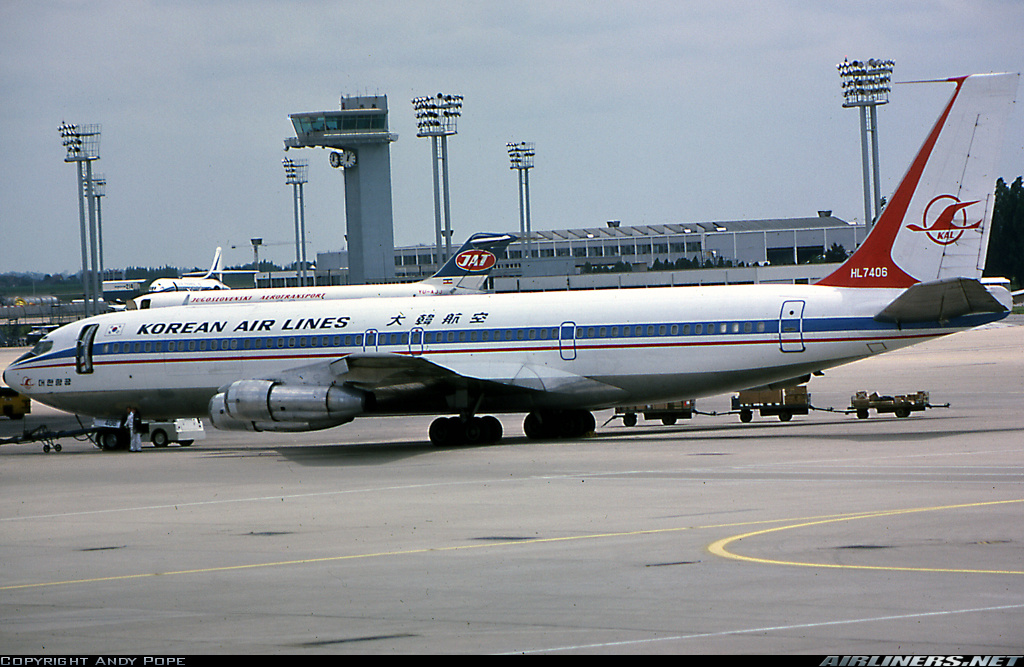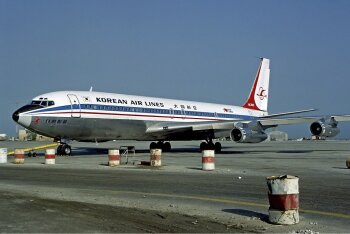On November 29, 1987, Korean Air Flight 858 was on its way from Abu Dhabi to Bangkok when all communications with the flight were suddenly lost. What first seemed like an aircraft malfunction or pilot error soon became known as the worst terrorist act involving both North and South Korea, with a dark purpose to throw off a major international event.
Flight Details
Korean Air Flight 858 originated at Saddam International Airport (now Baghdad International Airport) in Baghdad, with a stopover at Abu Dhabi International Airport and Don Mueang International Airport in Bangkok. The incident occurred on the second leg of the flight, on its way from Abu Dhabi to Bangkok. There were 104 passengers and 11 crew members on board.
The aircraft operating Flight 858 was a Boeing 707-3B5C with line number 648 and registration HL7406. This 707 was built on June 21, 1971, and started flying for Korean Air Lines (now Korean Air) on August 11, the same year. It had 171 seats when it was delivered. HL7406 flew the inaugural KE001/KE002 flight from Seoul to Tokyo, then to Honolulu and finally Los Angeles.

HL7406 was valuable to Korean Air, as it was the first new aircraft that Korean Air had ordered from Boeing. Before HL7406, Korean Air operated two Boeing 720s second-hand from Eastern Air Lines and leased a single Boeing 707-320C freighter to operate cargo routes. Hence, HL7406 was the one and only Boeing 707 that had Korean Air's Boeing Customer Code B5.
HL7406 was also used as the first official presidential aircraft for South Korea from 1980 to 1982. After returning to regular passenger service, HL7406 went through a livery change after June 1984 in the current Korean Air blue livery. At the time of the incident, there was an additional special decal to promote the 1988 Seoul Olympics.

Ten years later, on September 2, 1987, almost three months before the bombing, the aircraft experienced the same nose gear issue while approaching the same airport and made another belly landing. After repair, the plane returned to operation, with its first destination being Baghdad. Flight 858 was the return flight for this planned trip.
The Incident
Flight 858 took off from Baghdad with 99 passengers, 15 of whom disembarked at Abu Dhabi. 13 of the 15 passengers terminated their journey at Abu Dhabi. In comparison, the other two Japanese passengers transferred to Bahrain on Gulf Air Flight 003. However, these Japanese passengers would soon reveal their true identity as the worst terrorists in Korean history.
After 11 new passengers boarded at Abu Dhabi, the flight took off for the second stopover in Bangkok. Nine hours into the flight, at around 5:05 a.m. UTC, while nearing its destination in Bangkok, the captain transmitted the final radio message saying, "We expect to arrive in Bangkok on time. Time and location normal".
Shortly after the message, all communications with Flight 858 were lost, and the aircraft disappeared from radar. Initially, it was thought there was a mechanical failure as the plane had a history of failing. However, on December 1, two days after the incident, the arrest and death of Japanese passengers who boarded Flight 858 directed the case towards a whole other story.
The terrorists left a radio-timer bomb in the overhead compartment near their seats, 7B and 7C. It was set to explode nine hours after it was set. After disembarking at Abu Dhabi, the two Japanese passengers, Hachiya Shinichi, male, age 70, and Hachiya Mayumi, female, age 25, transferred on Gulf Air Flight 003 to Bahrain. They were supposed to head to Amman and Rome, meet with other agents in Vienna, and return to North Korea.
However, as they were asked for boarding passes at Abu Dhabi, the bombers diverted to Bahrain to avoid attention regarding visa problems. As they arrived in Bahrain, they searched for flights out of the country, but the reservation offices were closed as it was a Sunday, and Monday flights were sold out. The bombers had to stay at the Regency InterContinental Hotel in Bahrain, where an employee from the South Korean Embassy in Bahrain visited their hotel room to ask questions about Flight 858.
It is believed that South Korea was suspicious of the two from this point. On December 1, the bombers headed towards the airport to leave Bahrain. However, the Japanese passports were identified as forged at the airport. The two bombers resisted arrest and attempted suicide by ingesting cyanide that was concealed inside cigarettes. The male bomber died, but the female bomber survived the dose, failing to commit suicide.

Upon hearing this news, the South Korean government quickly asserted that these passengers were spies from North Korea, proving that using cyanide is a common practice for North Korean agents. As a result, the bomber was extradited to South Korea for further investigation instead of being sent to Japan for using a forged Japanese passport.
Hachiya Mayumi arrived in South Korea on board a chartered Korean Air DC-10 on December 15, almost two weeks after the attack. This was the day before the presidential elections in South Korea. After interrogation, it was revealed that this person was, in fact, Kim Hyon Hui, a North Korean agent. The deceased male was identified as Kim Seung Ill, also a North Korean agent.
The investigators concluded that the purpose of this bombing was to disrupt the upcoming presidential elections and deter countries from participating in the 1988 Summer Olympics in Seoul. There were previous attempts by North Korea to destabilize the South Korean government, as well as prevent the Seoul Olympics from happening. These include the Rangoon Bombing in 1983 and the Gimpo International Airport bombing in 1986, which occurred six days before the 1986 Asian Games hosted by Seoul.
Aftermath
Flight 858's bombing brought anger not only from South Korea but all over the world. Kim was sentenced to death but was later pardoned to get classified information about North Korea. It is said that her family and relatives that remain in North Korea were all sent to labor camps and expelled from the Pyongyang Capital Area.
Kim wrote two books about her life in the early 1990s and offered more than $600,000 in royalty profits to victims' families. She is currently living under the protection of the National Intelligence Service of South Korea. She married an ex-agent of the National Intelligence Service and has one son and one daughter.
As the bombing occurred near the presidential election, the ruling party was able to use the bombing to win the election by promptly pursuing punishment and widely broadcasting the capture of the terrorist. The Korean War still affected most South Korean citizens at the time, and such news made a good impression on the public. In the end, with the unification of candidates of the opposing party falling through, the ruling party was able to continue running the regime.

The remains of Flight 858 were never fully recovered at the time, and the government showed poor interest in the swift recovery of remains. This led to conspiracy theories saying that the whole thing was all staged by the South Korean Government, and is still debated to this day.
In 2019, MBC, a South Korean broadcast company, found debris that is thought to be the fuselage of Flight 858. This was 32 years after the bombing, but the fuselage was found to be intact, suggesting that the 707 did not plunge violently into the ocean but rather made a failed emergency landing in the sea.
On November 27, 2020, MBC announced that the South Korean government agreed with the Myanmar government to send investigators to the debris site. However, the investigation was halted due to the Myanmar coup d'état that happened on February 1, 2021. MBC uploaded a video emphasizing the importance of a re-investigation last December.

A memorial for the victims of Flight 858 is located in Yangjae Citizen Forest, Seoul, South Korea.
Emirates Dismisses Viral A330 Plane Crash Video as "Fabricated and Untrue" » Bomb Threat Cancels Air New Zealand Flight, Delays Passengers » Maldivian Airlines Introduces First-Ever Widebody Aircraft, Plans New China Flights »
Comments (0)
Add Your Comment
SHARE
TAGS
STORIES Olympics Seoul North Korea Terrorism Korean Air Sports South Korea Incident Safety Emergency Boeing Boeing 707RECENTLY PUBLISHED
 Could You Survive a Plane Crash? The Unlikely Science of Plane Crash Survival
With air travel consistently being heralded as the safest form of public transport, most of us do not board a plane pondering our chances of survival in the event of a crash. But, is it possible to survive one?
INFORMATIONAL
READ MORE »
Could You Survive a Plane Crash? The Unlikely Science of Plane Crash Survival
With air travel consistently being heralded as the safest form of public transport, most of us do not board a plane pondering our chances of survival in the event of a crash. But, is it possible to survive one?
INFORMATIONAL
READ MORE »
 Maldivian Airlines Introduces First-Ever Widebody Aircraft, Plans New China Flights
Maldivian, the government-owned national airline of the Maldives, has just welcomed its first-ever wide body aircraft: the Airbus A330-200. With the new aircraft, the carrier also plans brand-new long haul international flights to China.
NEWS
READ MORE »
Maldivian Airlines Introduces First-Ever Widebody Aircraft, Plans New China Flights
Maldivian, the government-owned national airline of the Maldives, has just welcomed its first-ever wide body aircraft: the Airbus A330-200. With the new aircraft, the carrier also plans brand-new long haul international flights to China.
NEWS
READ MORE »
 Thousands of Flights Impacted as Winter Storm Blair Hits U.S.
Winter Storm Blair has unleashed a huge blast of snow, ice, and freezing temperatures across the Central and Eastern United States.
As of Sunday afternoon, over 6,700 flights and counting have been disrupted. This includes cancelations and significant delays leaving passengers scrambling to change flights and adjust travel plans.
NEWS
READ MORE »
Thousands of Flights Impacted as Winter Storm Blair Hits U.S.
Winter Storm Blair has unleashed a huge blast of snow, ice, and freezing temperatures across the Central and Eastern United States.
As of Sunday afternoon, over 6,700 flights and counting have been disrupted. This includes cancelations and significant delays leaving passengers scrambling to change flights and adjust travel plans.
NEWS
READ MORE »





